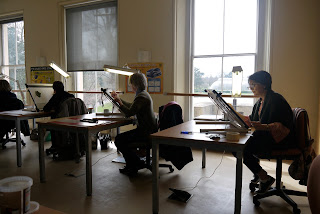Time to do a little more work on my leaves in the morning. I am sticking to dots for the camellia and hatching for the ivy. I am using a Gilot 404 now and sumi stick ink.
Now back to the challenge of measuring in three dimensions - I don't find it easy with the dividers - I would much rather stick to my old skills of comparing shapes and looking at negative space. I do spend a lot of time scanning the object and my drawing - but a bit like finding the sculpture inside a piece of stone I prefer to end up with a clean line from a very light sketch and then rubbing out the mistakes. This is not the way we are being taught which instead concentrates on measuring every single detail and vein with dividers and plotting it on the page. When working from a habit, or whole plant, this has to be done on an imaginary piece of glass in front of the plant so that everything is exactly life size.
I do however find it useful to use the dividers to scale up from a section under the microscope - I'm only working at 10.5x magnification at the moment and the drawing is x3.































